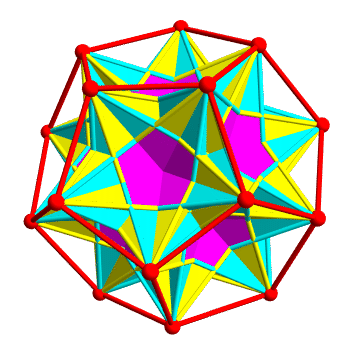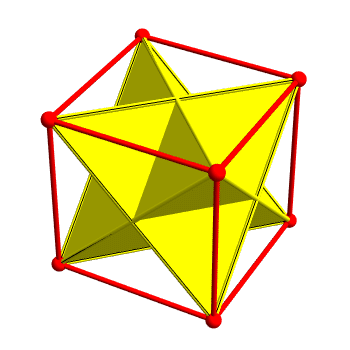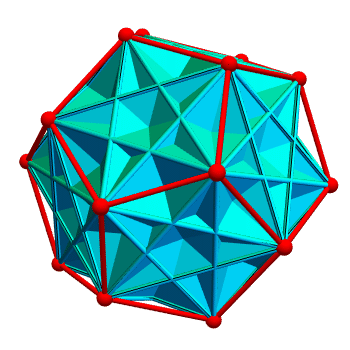This image by Greg Egan shows 5 ways to inscribe a regular tetrahedron in a regular dodecahedron. More precisely, it shows 5 ways to choose 4 vertices of the dodecahedron that are also vertices of a regular tetrahedron.
The union of all these tetrahedra is a nonconvex polyhedron called the compound of 5 tetrahedra, first described by Edmund Hess in 1876.
This polyhedron is chiral: it has no reflection symmetries. In rough terms, it has an inherent ‘left-handedness’: if you start at a point where the 5 tetrahedra meet, you’ll see the lines of intersection ‘swirl counterclockwise’ as they go out.
In fact there are 10 ways to inscribe a regular tetrahedron in a regular dodecahedron. 5 form the left-handed polyhedron above, and the other 5 give the right-handed version of this polyhedron. The union of all 10 tetrahedra is a polytope called compound of 10 tetrahedra, which has reflection symmetries:
The two kinds of tetrahedra are colored yellow and cyan. Regions belonging to both are colored magenta. It’s pretty—but it’s hard to see the individual tetrahedra, because they overlap a lot.
We can do something similar starting with a cube:
There are 2 ways to inscribe a regular tetrahedron in a cube. Taken together they form a nonconvex polyhedron called the stellated octahedron.
There are 5 ways to inscribe a cube in a dodecahedron. Their union is called the compound of 5 cubes:
Inscribing 2 tetrahedra in each of these cubes, we obtain the 10 tetrahedra in the dodecahedron.
What is the mathematics underlying these relationships between the tetrahedron, cube and dodecahedron? The finite subgroups of the rotation group SO(3) can be classified, up to conjugation:
• for each n≥1, the cyclic group Z/n,
• for each n≥2, the dihedral group Dn,
• the rotational symmetry group of the tetrahedron, which is isomorphic to the alternating group A4, the group of even permutations of the tetrahedron’s 4 vertices.
• the rotational symmetry group of the cube, which is isomorphic to the symmetric group S4, the group of permutations of the cube’s 4 diagonal axes.
• the rotational symmetry group of the dodecahedron, which is isomorphic to the symmetric group A5, the group of even permutations of the 5 cubes inscribed in the dodecahedron.
So, what’s at work here is a relation between A4,S4 and A5, both as abstract groups and as subgroups of SO(3).
• Tetrahedron and cube. A4 is a subgroup of S4. So, every symmetry of an inscribed tetrahedron gives a symmetry of the cube. Since A4 is a subgroup of S4 in a unique way, both tetrahedra in the cube have the same subgroup of S4 as symmetries—not merely conjugate subgroups.
• Tetrahedron and dodecahedron. A4 is a subgroup of A5. So, every symmetry of an inscribed tetrahedron gives a symmetry of the dodecahedron. A4 is a subgroup of A5 in 5 different ways that are all conjugate. For each of these 5 subgroups, 2 of the 10 tetrahedra in the dodecahedron have this subgroup as symmetries.
• Cube and dodecahedron. S4 is not a subgroup of A5. So, not every symmetry of an inscribed cube gives a symmetry of the dodecahedron.
Puzzle 1: Describe a tetrahedron in a cube, tetrahedron in a dodecahedron or cube in a dodecahedron using the language of group theory. Use this to explain why there are 2 tetrahedra in the cube, 10 tetrahedra in the dodecahedron and 5 cubes in the dodecahedron.
Puzzle 2: A4 is a normal subgroup of S4 but not of A5. How does this make tetrahedra in the cube different than tetrahedra in the dodecahedron?
For more, see:
• Alternating group A4, Groupprops.
• Symmetric group S4, Groupprops.
• Alternating group A5, Groupprops.
• Classification of finite subgroups of SO(3), Groupprops.
Visual Insight is a place to share striking images that help explain advanced topics in mathematics. I’m always looking for truly beautiful images, so if you know about one, please drop a comment here and let me know!








Hey!
I find polyhedra very interesting. Can someone recommend some nice book from where I can study about them particularly the formal abstractions of symmetry groups, graph theory and such? I’m not interested in generalizing the theory to higher dimensional space. I like what I can see and model. And although I know the power and beauty of abstractions I am still not keen on studying abstractions for the sake of it.
Thanks. I would really appreciate your suggestion.
It seems sad to limit yourself to 3 dimensions, since it’s not too hard to draw and visualize 4d polytopes, and the 4th dimension is the most exciting dimension for regular polytopes. Anyway, this book by ‘the king of geometry’ is the best place to read about regular polytopes in 2, 3, 4 and higher dimensions:
• H. S. M. Coxeter, Regular Polytopes.
but if you want books that only talk about 3d polytopes there’s a long list of choices here:
• Wikipedia, List of books about polyhedra.
I haven’t looked at them carefully, so I can’t guess which ones you’d like.
What sort of answer was expected for Puzzle 1 exactly?
The group of rotational symmetries of the dodecahedron is A5. The subgroup of symmetries preserving a tetrahedron inscribed in the dodecahedron is isomorphic to A4. So, the set of tetrahedra inscribe in the dodecahedron is isomorphic to A5/A4. Since A5 has 5!/2 = 60 elements and A4 has 4!/2 = 12 elements, A5/A4 has 60/12 = 5 elements.
Similar analyses work for the other parts of this puzzle, but they don’t all go exactly the same way. The general idea is to use Klein geometry, but with finite groups instead of Lie groups.